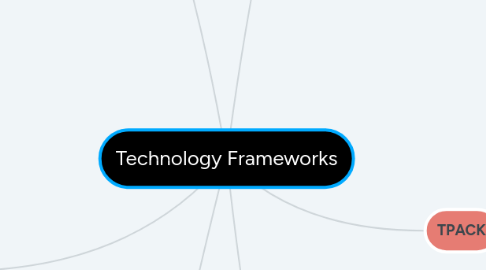
1. PICRAT
1.1. Created by Royce Kimmons from BYU-Provo.
1.2. PIC: Passive, Interactive, Creative (deals with student reaction and attitude toward tech)
1.2.1. An example of Passive Replacement is video lecture as opposed to a face to face one.
1.3. RAT: Replace, Amplify, Transform (deals with the teachers' integration of technology relative to traditional methods, ie. it replaces, amplifies, or transforms traditional methods)
1.4. Combining one letter from each category creates a matrix for how technology can be used effectively in classes.
1.4.1. Different combinations are helpful depending on the circumstance of the students or the particular assignment.
2. Triple E
2.1. Enhance, Engage, Extend
2.1.1. Engage
2.1.1.1. Does the technology allow the students to focus on the task without distraction?
2.1.1.2. Does the technology motivate students to start the learning process?
2.1.1.3. Does the technology cause the students to shift from passive to active social learners?
2.1.2. Enhance
2.1.2.1. Does the technology aid the students in demonstrating better understanding of the content?
2.1.2.2. Does the technology create scaffolds that help make learning and understanding concepts easier?
2.1.2.3. Does the technology create ways for the students to demonstrate their understanding in a way that they could not with traditional methods?
2.1.3. Extend
2.1.3.1. Does the technology create opportunities for the students to learn outside their school days?
2.1.3.2. Does the technology create a bridge between school learning and everyday life?
2.1.3.3. Does the technology create ways for the students to demonstrate their understanding of learning goals that they wouldn't have with traditional methods?
2.1.4. Teachers should focus first on the content and objectives, then should support that with technology that enhances, engages, and extends the learning.
2.2. Created by Liz Kolb from the University of Michigan
3. Similarities
3.1. All deal with enhancement of traditional methods in some shape or form.
3.2. There are pros and cons with each in determining whether the technology is truly useful.
3.3. All methods run the risk of integrating technology for technology's sake.
3.4. It also runs the risk of copying traditional methods that are ineffective rather than improving.
3.5. All methods advise starting with content and objectives then supporting with technology rather than the other way around.
4. SAMR
4.1. Most common SAMR frame was made by Ruben Puentedura.
4.2. Substitution, Augmentation, Modification, Redefinition
4.2.1. Substitution: technology acts as a direct substitute with no functional change (Enhancement)
4.2.1.1. What is gained by replacing traditional tools with technology?
4.2.1.2. Digital access to reading vs paper copies; watching a video vs direct teaching
4.2.2. Augmentation: technology acts as a direct substitute with functional improvement (Enhancement)
4.2.2.1. Does the technology augment or enhance the students' productivity and/or potential?
4.2.2.2. Powerpoint presentation vs poster presentation; using Google Earth rather than a traditional map
4.2.3. Modification: technology allows for significant task redesign (Transformation)
4.2.3.1. Does technology significantly alter the task?
4.2.4. Redefinition: technology allows for the creation of new tasks previously inconceivable (Transformation)
4.2.4.1. Do the technology tools allow educators to redefine a traditional task in a way that would not be possible without the tech, creating a novel experience?
4.2.4.2. Contacting someone from around the world to learn about the geography in that area.
4.2.5. The levels act as a spectrum with one end directly replacing traditional methods and the other end acting as an enhancer for things that weren't possible before.
4.2.6. Adding more interactive and creative elements is a good way to move the activity up the SAMR scale.
4.3. Some teachers may use SAMR and Bloom's Taxonomy in tandem, but it is not always effective because the two models are for very different purposes.
5. TPACK
5.1. Technological Pedagogical Content Knowledge
5.2. Represented with a Venn Diagram of Technological Knowledge, Content Knowledge, and Pedagogical Knowledge.
5.2.1. Peak technology integration is reached when the method includes pedagogy, content knowledge, and technology all at once.
5.2.1.1. Uses for this vary based on the context of specific classrooms.
5.2.1.2. First start with content and pedagogy, then layer in technology, rather than focusing a lesson on a technological tool, method, or concept.
5.2.2. Technological is how technology is used
5.2.2.1. Knowledge of technological tools
5.2.3. Content is what the teachers know
5.2.3.1. Facts, concepts, and theories of the disciplines
5.2.4. Pedagogical is how the teacher teaches
5.2.4.1. Instructional methods, assessment, teaching strategies, etc.
5.2.5. Content Pedagogical Knowledge was commonly recognized as teaching at its best, where teachers can effectively teach the content they know
5.2.5.1. It is now commonly believed that teaching at its best is when a teacher can effectively teach the content they know using technology where it is most effective.
5.2.6. Technological Content Knowledge is how technology is used in a content area to create deep and lasting learning.
5.2.7. Technological Pedagogical Knowledge is a teacher's understanding of how to choose and manage technology for the students.
6. Differences
6.1. TPACK
6.1.1. More detailed; features a Venn Diagram for the different combinations of knowledge; lines between knowledge areas is more distinct; focuses methods on more than just technology
6.2. Triple E
6.2.1. Formed more as guidelines than stages; the only specified step is adding technology; more focused on the tech aspect itself rather than different areas of pedagogy; not as specifically detailed as TPACK and SAMR
6.3. SAMR
6.3.1. Formed more as a progression of integration; outlines more precise ways of integrating technology; lines between stages are more blurred; more of a spectrum than actual different areas
